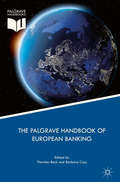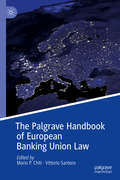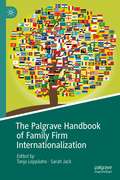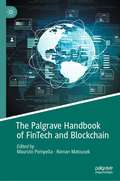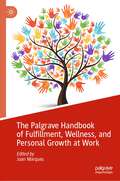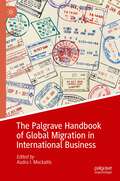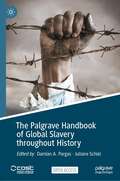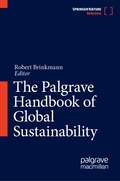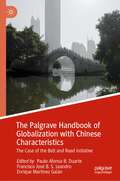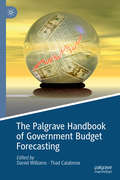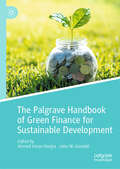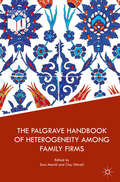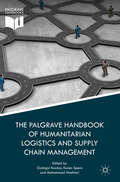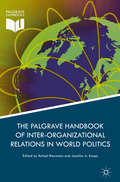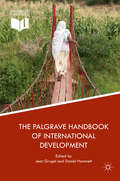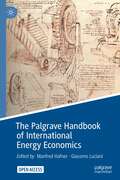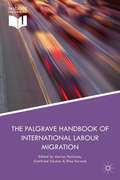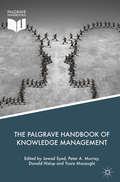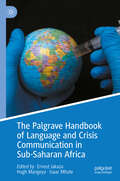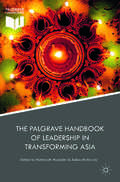- Table View
- List View
The Palgrave Handbook of Environmental Politics and Theory (Environmental Politics and Theory)
by Joel Jay Kassiola Timothy W. LukeThis Handbook aims to provide a unique and convenient one-volume reference work, exhibiting the latest interdisciplinary explorations in this urgently burgeoning field of intellectual and practical importance. Due to its immense range and diversity, environmental politics and theory necessarily encompasses: empirical, normative, policy, political, organizational, and activist discussions unfolding across many disciplines. It is a challenge for its practitioners, let alone newcomers, to keep informed about the ongoing developments in this fast-changing area of study and to comprehend all of their implications. Through the planned volume’s extensive scope of contributions emphasizing environmental policy issues, normative prescriptions, and implementation strategies, the next generation of thinkers and activists will have very useful profiles of the theories, concepts, organizations, and movements central to environmental politics and theory. It is the editors’ aspiration that this volume will become a go-to resource on the myriad perspectives relevant to studying and improving the environment for advanced researchers as well as an introduction to new students seeking to understand the basic foundations and recommended resolutions to many of our environmental challenges. Environmental politics is more than theory alone, so the Handbook also considers theory-action connections by highlighting the past and current: thinkers, activists, social organizations, and movements that have worked to guide contemporary societies toward a more environmentally sustainable and just global order. Chapter “Eco-Anxiety and the Responses of Ecological Citizenship and Mindfulness” is available open access under a Creative Commons Attribution 4.0 International License via link.springer.com.
The Palgrave Handbook of ESG and Corporate Governance
by Paulo Câmara Filipe MoraisSince the 2008 Global Financial Crisis the prevailing economic development model based on an assumption of unlimited resources and, therefore, unlimited growth has been increasingly put into question by academics, policy-making agencies and even industry leaders themselves. Climate change, general environmental and natural resource degradation, widespread inequalities, and systemic governance failures are pressing capitalism to renew itself to deliver sustainable outcomes for a broader base of stakeholders. This has become known in more practical terms as the ESG (Environmental, Social and Governance) and responsible investment movements. The pressure to change how we organise ourselves as societies and economies has implications for how large and small corporations, public or private, are governed and to the benefit of whom. This Handbook offers a rare combination of pluralistic and multidisciplinary perspectives from law, economics, finance and management, as well as an interesting mix of latest academic thinking and practical recommendations on ESG for boards and executive teams.Should companies be governed and managed for the benefit of their shareholders alone? Can companies be governed to deliver for shareholders as well as the broader stakeholder base? How can investors allocate capital to advance sustainability? Part I provides a pluralistic discussion of some of these fundamental questions besetting academics and practitioners alike while Part II examines recent regulatory developments and assesses what may need to change in terms of law and regulation to both hold companies to account for sustainability while enabling them to continue to provide vital goods and services. Part III of the book discusses how the different types of companies and investors are currently facing the sustainability imperative and incorporating ESG factors on how they operate and invest. The concluding chapter provides an overview of the key regulatory, ecosystem and board-level gaps that require urgent and decisive action.
The Palgrave Handbook of European Banking
by Thorsten Beck Barbara CasuThis handbook presents a timely collection of original studies on relevant themes, policies and developments in European banking. The contributors analyse how the crisis years have had a long lasting impact on the structure of European banking and explore the regulatory architecture that has started to take form in their wake. Academic experts and senior policy makers have contributed to this volume, which is organized in five main parts. The first part presents an overview of European banking through the crisis and beyond. The second part analyses performance and innovation in EU banking markets. The third part discusses the key regulatory changes aimed at fostering financial stability. Part four looks at the relevance of cross-border banking and part five presents a detailed analysis of the main EU banking markets. This is a highly informative and carefully presented handbook, which provides thought-provoking insights into the past, present and future landscapes of European banking. It will appeal to a wide readership, from scholars and students, through to researchers, practitioners and policy-makers.
The Palgrave Handbook of European Banking Union Law
by Mario P. Chiti Vittorio SantoroThis handbook analyses the European Banking Union legal framework focusing on legislative acts (regulations and directives), case law and the resolution procedures. In addition, it will pay attention to the division of responsibilities between the ECB and the national authorities, with special attention to the Single Supervisory Mechanism (SSM) and the Single Resolution Mechanism (SRM). To give a more complete picture, the book will also cover the implementation of European Deposit Insurance Scheme (so called third pillar) still under construction, and appeal to academics, researchers and students of banking and financial law.
The Palgrave Handbook of Family Firm Internationalization
by Tanja Leppäaho Sarah JackFamily Firms (FFs) form the majority of all firms around the world and they account for an enormous percentage of the employment, the revenue, and the GDP of most capitalist countries. While MNCs have long been thought of as the main contributors to international business, it is now recognised that a substantial number of family firms are active in the international arena. This handbook focuses on the features which make family firm internationalization unique. Chapters provide FF specific theories and cover the process of FF internationalization. It examines the role of network ties and provides an insight into the development of family firms that have grown into big multinationals. Importantly this Handbook equips you with a better understanding of specific features of family firms as they internationalize from or to Asian or emerging markets. Family firms offer a fruitful context to study internationalization through a process perspective, therefore this Handbook is an invaluable source of knowledge for students, scholars and policy makers in the areas of family business, entrepreneurship and internationalization.
The Palgrave Handbook of FinTech and Blockchain
by Roman Matousek Maurizio PompellaFinancial services technology and its effect on the field of finance and banking has been of major importance within the last few years. The spread of these so-called disruptive technologies, including Blockchain, has radically changed financial markets and transformed the operation of the industry as a whole. This is the first multidisciplinary handbook of FinTech and Blockchain covering finance, economics, and legal aspects globally. With comprehensive coverage of the current landscape of financial technology alongside a forward-looking approach, the chapters are devoted to the spread of structured finance, ICT, distributed ledger technology (DLT), cybersecurity, data protection, artificial intelligence, and cryptocurrencies. Given an unprecedented 2020, the contributions also address the consequences of the current emergency, and the pandemic stroke, which is revolutionizing social and economic paradigms and heavily affecting Fintech, Blockchain, and the banking sector as well, and would be of particular interest to finance academics and researchers alongside banking and financial services professionals.
The Palgrave Handbook of Fulfillment, Wellness, and Personal Growth at Work
by Joan MarquesThis handbook discusses the role of sustainability, well-being and growth in engagement and purpose at work. When employees are dissatisfied with their job, they tend to be disengaged and less productive. Given the correlation between job satisfaction and job performance, organizations are looking for ways to increase employee engagement and productivity.Divided into three sections, this work opens with an examination of the concept of work, then discusses fulfillment of workforce members at mental, emotional, and spiritual levels. The next section on wellness explores drivers that advance interhuman approaches and trends, including meaning, leadership, happiness, resilience, and motivation. The last section focuses on personal and professional growth through the cultivation of an entrepreneurial mindset, but also justice, equity, and interactive flourishing through the promotion of positive trends or the conscious reduction of toxic ones.With contributions from a global cluster of scholars, this book offers readers broad perspectives on the potential nature of work as a gratifying vocation. It will serve as a horizon-expanding reference for those researching topics related to meaningful work and workplace fulfillment and thriving.
The Palgrave Handbook of Global Migration in International Business
by Audra I. MockaitisThis handbook focuses on the dynamic nature of global migration and its implications for international business. Migration shapes the societal and organizational contexts of international business; yet studies on migration have only recently become more prominent. For example, the existence of multinational enterprises (MNEs) depends to no small extent on the mobility of people; MNEs source, develop, deploy, and utilize global talent. This talent pool includes, but is not limited to, skilled expatriates or corporate migrants, as well as culturally and ethnically diverse workforces comprised of first- and second-generation migrants, highly skilled refugees that help organizations enhance their legitimacy in host countries, and returnee immigrants encouraged by changing home country conditions. Additionally, global events such as the COVID-19 pandemic and Brexit have introduced new and far-reaching challenges for international firms in managing their international workforces and international mobility. Meanwhile, at the individual level, these issues are compounded for migrants having to cope with multiple work and non-work demands. Chapters in this handbook offer both firm and migrant perspectives, covering topics such as diaspora networks in international alliances, migrant careers, and migrant re-entry issues, among others. Arranged in five sections, this handbook covers the whole spectrum of issues, thus furthering our understanding of this increasingly important topic.
The Palgrave Handbook of Global Slavery throughout History
by Damian A. Pargas Juliane SchielThis open access handbook takes a comparative and global approach to analyse the practice of slavery throughout history. To understand slavery - why it developed, and how it functioned in various societies – is to understand an important and widespread practice in world civilisations. With research traditionally being dominated by the Atlantic world, this collection aims to illuminate slavery that existed in not only the Americas but also ancient, medieval, North and sub-Saharan African, Near Eastern, and Asian societies. Connecting civilisations through migration, warfare, trade routes and economic expansion, the practice of slavery integrated countries and regions through power-based relationships, whilst simultaneously dividing societies by class, race, ethnicity and cultural group. Uncovering slavery as a globalising phenomenon, the authors highlight the slave-trading routes that crisscrossed Africa, helped integrate the Mediterranean world, connected Indian Ocean societies and fused the Atlantic world. Split into five parts, the handbook portrays the evolution of slavery from antiquity to the contemporary era and encourages readers to realise similarities and differences between various manifestations of slavery throughout history. Providing a truly global coverage of slavery, and including thematic injections within each chronological part, this handbook is a comprehensive and transnational resource for all researchers interested in slavery, the history of labour, and anthropology.
The Palgrave Handbook of Global Sustainability
by Robert BrinkmannThe field of sustainability continues to evolve as a discipline. The world is facing multiple sustainability challenges such as climate change, water depletion, ecosystem loss, and environmental racism. The Handbook of Sustainability will provide a comprehensive reference for the field that examines in depth the major themes within what are known as the three E’s of sustainability: environment, equity, and economics. These three themes will serve as the main organizing body of the work. In addition, the work will include sections on history and sustainability, major figures in the development of sustainability as a discipline, and important organizations that contributed or that continue to contribute to sustainability as a field. The work is explicitly global in scope as it considers the very different issues associated with sustainability in the global north and south
The Palgrave Handbook of Globalization with Chinese Characteristics: The Case of the Belt and Road Initiative
by Paulo Afonso B. Duarte Francisco José B. S. Leandro Enrique Martínez GalánThis handbook offers readers various perspectives on globalization and multilateralism with Chinese characteristics. Its originality is derived from the hybrid approaches the handbook takes, where chapters provide complementary, intertwined, and multi-level analysis on the topic. Based on contributions of scholars and practitioners from a number of countries, the handbook helps readers to comprehend ongoing debates on the Belt and Road Initiative and global governance, within a shifting balance of world power, characterized by competing views between Western and Chinese norms, standards, values, and narratives.Split into three Parts, and consisting of 46 chapters, the handbook views globalization as comprehensive concept that benefits from the contributions of various disciplines such as geography, geo-economics, political science and international relations. In producing one of the most ambitious and updated outputs on the topic, the handbook as a whole seeks to discuss what globalization with Chinese characteristics looks like, and the role of the Belt and Road Initiative in this process.
The Palgrave Handbook of Government Budget Forecasting (Palgrave Studies in Public Debt, Spending, and Revenue)
by Daniel Williams Thad CalabreseThis Handbook is a comprehensive anthology of up-to-date chapters contributed by current researchers in budget forecasting. Editors Daniel Williams and Thad Calabrese had previously found substantial deficiencies in public budgeting forecast literature with current research failing to address such matters as practices related to forecasting expenditure factors, the consequences of forecast bias, or empirical examination of the effectiveness of many deterministic methods actually used by many governments. This volume comprehensively addresses the state of knowledge about budget forecasting for practitioners, academics, and students and serves as a comprehensive resource for instruction alongside serving as a reference book for those engaged in budget forecasting practice.
The Palgrave Handbook of Green Finance for Sustainable Development (Palgrave Studies in Impact Finance)
by Ahmed Imran Hunjra John W. GoodellThis book covers green finance with a focus on the environmental, social, and governance (ESG) consequences of green financing and its role in attaining sustainable development and a carbon-neutral economy. It provides research-based practical solutions for sustainable development, as well as insights from green finance, presenting a framework for studying green finance in the domains of accounting, banking, investing, and insurance. Of interest to academics, investors, and policymakers in green finance and development and alternative financing, the book features a global cast of contributors from both academia and practice.
The Palgrave Handbook of Heterogeneity among Family Firms
by Esra Memili Clay DibrellThis handbook is the definitive source of research on the differences among family firms. It provides a timely and thorough investigation of the variant strategies and behaviors undertaken by family firms today, taking a closer look at different configurations of family involvement and how they influence outcomes and success. While studies on differences between family and non-family firms are deeply rooted in the literature, this handbook uniquely examines the family firm heterogeneity research to date and the inner firm governance, financial and non-financial objectives, and strategies such as innovation, competitive dynamics, internationalization, and human resources management. The handbook pulls together the work of the most prominent names in family business from around the world, separating itself from the competition both in content and geographical scope. Future research directions provided in each chapter will spark further interdisciplinary scholarly work, and will be enlightening for researchers, educators, and practitioners who are currently limited to the narrow and exclusive literature and advance the burgeoning research on this important topic.
The Palgrave Handbook of Humanitarian Logistics and Supply Chain Management
by Gyöngyi Kovács Karen Spens Mohammad MoshtariFocusing on the specific challenges of research design and exploring the opportunities of conducting research in humanitarian logistics and supply chain management, this handbook is a significant contribution to future research. Chapters include extensive descriptions of methods used, highlighting their advantages and disadvantages, and the challenges in scoping, sampling, collecting and analysing data, as well as ensuring the quality of studies. Covering a wide variety of topics including risk and resilience and the impact of humanitarian logistics on capacity building, sustainability and the local economy, it also explores the need for scalability and co-ordination in the humanitarian network. Contributors provide important insight on future directions and offer crucial guidance for researchers conducting projects within the field.
Palgrave Handbook of Inter-Organizational Relations in World Politics
by Joachim A. Koops Rafael BiermannThis unique handbook brings together a team of leading scholars and practitioners in order to map, synthesize and assess key perspectives on cooperation and rivalry between regional and global organizations in world politics. For the first time, a variety of inter-disciplinary theoretical and conceptual perspectives are combined in order to assess the nature, processes and outcomes of inter-organizational partnerships and rivalries across major policy areas, such as peace and security, human rights and democratisation as well as finance, development and climate change . This text provides scholars, students and policy-makers of International Relations with an exhaustive reference book for understanding the theoretical and empirical dimensions of an increasingly important topic in International Relations (IR), Global Governance and related disciplines.
The Palgrave Handbook of Interactive Marketing
by Cheng Lu Wang<p>Interactive marketing, as one of the fastest growing academic fields in contemporary business world, is the multi-directional value creation and mutual-influence marketing process through active customer connection, engagement, participation and interaction. Contemporary interactive marketing has moved beyond the scope of direct marketing or digital marketing, as the market is becoming a forum for conversations and interactions among connected actors or participants in platform ecosystems. The advancement of mobile technology with interactive content and personalized experience makes interactive marketing the new normal in the business world.<p> <p>This handbook contains the most comprehensive and cutting-edge knowledge in the interactive marketing field. The 41 chapters that are divided into eight sections cover all aspects of contemporary interactive marketing realm, including social media and influencer marketing, big data and machine learning in predictive analytics, mobile marketing and proximity marketing, interactive digital marketing and Omnichannel marketing, AI, VR and AR in business applications. With a focal point on interactive marketing, this handbook takes a multidiscipline perspective, from new technology innovations, social media and platform application, economic and cultural impacts, social and psychological analysis, and management and information system.<p> <p>This book provides a timely and comprehensive textbook companion and/or course project resource for college educators and students used for variety of graduate and undergraduate marketing courses, such as Digital Marketing, Internet Marketing, Social Media Marketing, New Media Communication, Marketing Analytics and Marketing Management, etc. It offers valuable references for academic researchers who are interesting conducting and publishing in interactive marketing research. The state-of-art review and emerging new trends presented in the book are particularly useful for research idea generation and conceptual development. The book also putts forward insightful guidelines and practical tools for business management in the application of new interactive marketing strategies and applications in the real world practices.<p>
The Palgrave Handbook of Interactive Marketing
by Cheng Lu WangInteractive marketing, as one of the fastest growing academic fields in contemporary business world, is the multi-directional value creation and mutual-influence marketing process through active customer connection, engagement, participation and interaction. Contemporary interactive marketing has moved beyond the scope of direct marketing or digital marketing, as the market is becoming a forum for conversations and interactions among connected actors or participants in platform ecosystems. The advancement of mobile technology with interactive content and personalized experience makes interactive marketing the new normal in the business world.This handbook contains the most comprehensive and cutting-edge knowledge in the interactive marketing field. The 41 chapters that are divided into eight sections cover all aspects of contemporary interactive marketing realm, including social media and influencer marketing, big data and machine learning in predictive analytics, mobile marketing and proximity marketing, interactive digital marketing and Omnichannel marketing, AI, VR and AR in business applications. With a focal point on interactive marketing, this handbook takes a multidiscipline perspective, from new technology innovations, social media and platform application, economic and cultural impacts, social and psychological analysis, and management and information system. This book provides a timely and comprehensive textbook companion and/or course project resource for college educators and students used for variety of graduate and undergraduate marketing courses, such as Digital Marketing, Internet Marketing, Social Media Marketing, New Media Communication, Marketing Analytics and Marketing Management, etc. It offers valuable references for academic researchers who are interesting conducting and publishing in interactive marketing research. The state-of-art review and emerging new trends presented in the book are particularly useful for research idea generation and conceptual development. The book also putts forward insightful guidelines and practical tools for business management in the application of new interactive marketing strategies and applications in the real world practices.
The Palgrave Handbook of International Development
by Daniel Hammett Jean GrugelInternational development isa dynamic, vibrant and complex field - both in terms of practices and inrelation to framing and concepts. This collection draws together leadingexperts from a range of disciplines, including development economics, geography,sociology, political science and international relations, to explore persistentproblems and emergent trends in international development. Building from anintroduction to key development theories, this Handbook proceeds to examine keydevelopment questions relating to the changing donor and aid landscape, thechanging role of citizens and the state in development, the role of new financeflows and privatization in development, the challenges and opportunities ofmigration and mobility, emerging issues of insecurity and concerns with peopletrafficking, the drugs trade and gang violence, the role of rights and activismin promoting democracy and development, the threats posed by and responses toglobal environmental change, and the role of technology and innovation inpromoting development.
The Palgrave Handbook of International Energy Economics
by Manfred Hafner Giacomo LucianiThis open access handbook is distinguished by its emphasis on international energy, rather than domestic energy policies or international geopolitic aspects. Addressing key topics such as energy production and distribution, renewables and corporate energy structures, alongside global energy trends, regional case studies and emerging areas such as the digitalization of energy and energy transition, this handbook provides a major new contribution to the field of international energy economics. Written by academics, practitioners and policy-makers, this handbook is a valuable and timely addition to the literature on international energy economics.This book was published open access with the support of Eni.
The Palgrave Handbook of International Labour Migration
by Marion Panizzon Gottfried Z�rcher Elisa Fornal�This Handbook focuses on the complexity surrounding the interaction between trade, labour mobility and development, taking into consideration social, economic and human rights implications, and identifies mechanisms for lawful movements across borders and their practical implementation.
The Palgrave Handbook of International Trade and Development in Africa
by Matthew Kofi Ocran Joshua Yindenaba AborThis book explores the intricate activities and systems that underpin international trade and development in Africa. The relationship between trade and economic performance is analysed, with a particular emphasis on financial development, trade liberalization, and the welfare implications of FTA. A critical reflection of international trade and development in Africa is provided that highlights how institutions that govern the international trade system, largely found in the Global North, have enabled developed countries to benefit most from African trade. Emerging issues, such as FDI, the COVID-19 pandemic, the gendered nature of trade, remittances, and digital trade, are also discussed. This book aims to examine how Africa can play a more active role international trade and how the trade systems can be altered to help drive economic growth and development in Africa. It will be relevant to students and researchers interested in development and African economics.
The Palgrave Handbook of Knowledge Management
by Yusra Mouzughi Donald Hislop Peter A. Murray Jawad SyedThis international Handbook provides a comprehensive overview of key topics, debates and issues within the now well-established field of Knowledge Management (KM). With contributions from a range of highly-skilled authors, diverse and multi-disciplinary approaches towards KM are explored in this fantastic new reference work. Topics covered include performance, ethics, sustainability and cross-cultural management, making this an equally important read to academics and practitioners working in areas such as technology, education and engineering. By analysing how the field of KM has developed over the years, as well as presenting new methods to be implemented in the workplace, this Handbook outlines a research agenda for the future of organisational learning and innovation.
The Palgrave Handbook of Language and Crisis Communication in Sub-Saharan Africa
by Hugh Mangeya Isaac Mhute Ernest JakazaThis handbook provides a detailed and sustained examination of the scope, purpose and practical application of crisis and disaster management communication in this critical region of the African continent, sub-Saharan Africa (SSA). The volume lays the foundation that enables a nuanced appreciation of two significant issues. The first pertains to SSA’s vulnerability to both natural and man-made phenomena. Secondly, it argues that communication plays a critical role in so far as the identification, social construction, raising awareness, preparation, mitigation and eradication of crises and disasters in the region. Communication plays a critical role in potentially reducing the impacts of crises and disasters before their occurrence. This handbook is a key resource for academics, students and practitioners in areas such as political communication, media communication, language and communication, brand communication, social/digital media communication, and crisis communication, among others.
The Palgrave Handbook of Leadership in Transforming Asia
by Nuttawuth Muenjohn Adela McMurrayThis handbook provides a comprehensive overview and evaluation of the variety of organizational leadership issues within the Asian region. It highlights the relationship between leaders and their followers, and the complexity of leadership research and practices in Asian transformational economies. Covering a wide range of contexts and perspectives, the chapters are based on empirical studies with evidence-based findings that can be used as case studies for academics and practitioners. The handbook makes significant contributions to leadership theory including practice and assists international researchers, practitioners and students in understanding the influence of the Asian culture and its impact on leadership.


